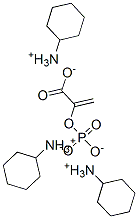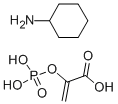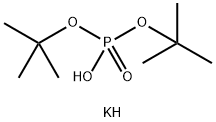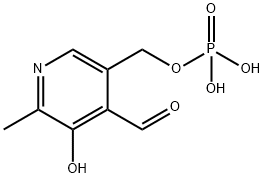PHOSPHOENOLPYRUVIC ACID MONOPOTASSIUM SALT
Synonym(s):2-(Phosphonooxy)-2-propenoic acid monopotassium salt;mono-Potassium phosphoenolpyruvate;PEP monopotassium salt;PEP-K;Phospho(enol)pyruvate potassium salt
- CAS NO.:4265-07-0
- Empirical Formula: C3H4KO6P
- Molecular Weight: 206.13
- MDL number: MFCD00044476
- EINECS: 224-247-0
- SAFETY DATA SHEET (SDS)
- Update Date: 2025-01-27 09:38:02

What is PHOSPHOENOLPYRUVIC ACID MONOPOTASSIUM SALT?
Description
Phosphoenolpyruvic acid plays a role in both glycolysis and gluconeogenesis. During glycolysis, it is formed by the action of enolase on 2-phosphoglycerate and is metabolized to pyruvate by pyruvate kinase. One molecule of ATP is formed during its metabolism in this pathway. During gluconeogenesis, it is formed from phosphoenolpyruvate carboxykinase-catalyzed oxaloacetate decarboxylation and GTP hydrolysis. In plants, it is metabolized to form aromatic amino acids and also serves as a substrate for phosphoenolpyruvate carboxylase-catalyzed carbon fixation.
Chemical properties
white to light yellow fine crystalline powder
The Uses of PHOSPHOENOLPYRUVIC ACID MONOPOTASSIUM SALT
Phosphoenolpyruvic acid monopotassium salt is used in glycolysis and gluconeogeneis. It is used for regeneration of ATP from ADP in enzyme-catalyzed syntheses. It is metabolized by an enzyme namely pyruvate kinase to yield pyruvate. It acts as protection against cell injury induced by oxidative stress and against dysfunction in carbohydrate metabolism.
The Uses of PHOSPHOENOLPYRUVIC ACID MONOPOTASSIUM SALT
Substrate for many kinase reactions.
What are the applications of Application
Phosphoenolpyruvic acid, monopotassium salt is a chemical involved in glycolysis and gluconeogeneis
General Description
Phospho(enol)pyruvic acid (PEP) acts as an inhibitor of hexokinase, phosphoglucose isomerase, phosphofructokinase and aldolase. It is a bifunctional carbohydrate, which exhibits antioxidant property. PEP may be a potential organ preservation agent in clinical transplantation.
Biochem/physiol Actions
Phospho(enol)pyruvic acid (PEP) is involved in glycolysis and gluconeogeneis. In glycolysis, PEP is metabolized by Pyruvate Kinase to yield pyruvate. In plants, PEP is involved in the formation of aromatic amino acids as well as in the carbon fixation pathway.
Purification Methods
KPEP is purified via the monocyclohexylamine salt (see next entry). The salt (534mg) in H2O (10mL) is added to Dowex 50Wx4 H+ form (200-400 mesh, 2mL, H2O washed) and stirred gently for 30minutes and filtered. The resin is washed with H2O (6mL), and the combined solutions are adjusted to pH 7.4 with 3N KOH (~1.4mL) and the volume adjusted to 18.4mL with H2O to give a solution of 0.1M KPEP which can be lyophilised to a pure powder and is very good for enzyme work. It has been recrystallised from MeOH/Et2O. [Clark & Kirby Biochemical Preparations 11 103 1966, Wold & Ballou J Biol Chem 227 301 1957, Cherbuliez & Rabinowitz Helv Chim Acta 39 1461 1956, Beilstein 3 IV 977.] The triNa salt [5541-93-5] M 360.0, is purified as follows: the salt (1g) is dissolved in MeOH (40mL) and dry Et2O is added in excess. The white crystals are collected and dried over P2O5 at 20o. [Cramer & Voges Chem Ber 92 952 1959, Beilstein 3 IV 977.]
Properties of PHOSPHOENOLPYRUVIC ACID MONOPOTASSIUM SALT
| Melting point: | 175 °C (dec.)(lit.) |
| storage temp. | 2-8°C |
| solubility | Methanol (Slightly), Water (Slightly) |
| form | solid |
| color | White to off-white |
| Water Solubility | Soluble in water. Slightly soluble in methanol. |
| Sensitive | Hygroscopic |
| BRN | 4603446 |
| CAS DataBase Reference | 4265-07-0(CAS DataBase Reference) |
| EPA Substance Registry System | 2-Propenoic acid, 2-(phosphonooxy)-, monopotassium salt (4265-07-0) |
Safety information for PHOSPHOENOLPYRUVIC ACID MONOPOTASSIUM SALT
| Signal word | Warning |
| Pictogram(s) |
 Exclamation Mark Irritant GHS07 |
| GHS Hazard Statements |
H315:Skin corrosion/irritation H319:Serious eye damage/eye irritation H335:Specific target organ toxicity, single exposure;Respiratory tract irritation |
| Precautionary Statement Codes |
P261:Avoid breathing dust/fume/gas/mist/vapours/spray. P271:Use only outdoors or in a well-ventilated area. P280:Wear protective gloves/protective clothing/eye protection/face protection. |
Computed Descriptors for PHOSPHOENOLPYRUVIC ACID MONOPOTASSIUM SALT
New Products
3-Iodophenylacetic acid 3-Pyridineacetonitrile, α-hydroxy- 2-Propanamine, 1-chloro-, hydrochloride (9CI) 3-(hexyloxy)-4-(pyridin-3-yl)-1,2,5-thiadiazole 2-Hexyn-1-ol Dibenzo-18-crown-6 Nickel(II) perchlorate hexahydrate, 98% 4-Bromophenylacetonitrile, 95% 3-Bromo-4-fluoroaniline, 97% Sodium tetraborate decahydrate, 98% Palladium(II) acetate, trimer, Pd 99% 4-Bromo-2-chlorotoluene, 97% N N Dimethylformamide Dimethyl Acetal (Dmf Dma) 2,3-Dichloro Benzoyl Cyanide [Side Chain] Bis(2-Chloroethyl) Amine Hydrochloride L-Glutamic Acid Diethyl Ester Hydrochloride 5-(Difluoromethoxy)-2-Mercaptobenzimidazole 1-Ethyl-3-(3-Dimethylaminopropyl)-Carbodiimide Hydrochloride [EDC Hcl] 1,4-Napthoquinone Bromoiodomethane Sodium Bicarbonate Methylene Dichloride (MDC) Ethyl Acetate Indole-3-Carbinol (I3C)Related products of tetrahydrofuran








You may like
-
 Phosphoenolpyruvic acid monopotassium salt 95% CAS 4265-07-0View Details
Phosphoenolpyruvic acid monopotassium salt 95% CAS 4265-07-0View Details
4265-07-0 -
 Phosphoenol-pyruvate CAS 4265-07-0View Details
Phosphoenol-pyruvate CAS 4265-07-0View Details
4265-07-0 -
 17604-74-9 3-Pyridineacetonitrile, α-hydroxy- 98+View Details
17604-74-9 3-Pyridineacetonitrile, α-hydroxy- 98+View Details
17604-74-9 -
 131987-69-4 98+View Details
131987-69-4 98+View Details
131987-69-4 -
 Cyclohexane, (2-propynyloxy)- 67967-07-1 98+View Details
Cyclohexane, (2-propynyloxy)- 67967-07-1 98+View Details
67967-07-1 -
 2-Propanamine, 1-chloro-, hydrochloride (9CI) 98+View Details
2-Propanamine, 1-chloro-, hydrochloride (9CI) 98+View Details
5968-21-8 -
 3-Iodophenylacetic acid 1878-69-9 98+View Details
3-Iodophenylacetic acid 1878-69-9 98+View Details
1878-69-9 -
 132945-75-6 (S)-1-Boc-3-methanesulfonyloxy-pyrrolidine 98+View Details
132945-75-6 (S)-1-Boc-3-methanesulfonyloxy-pyrrolidine 98+View Details
132945-75-6
